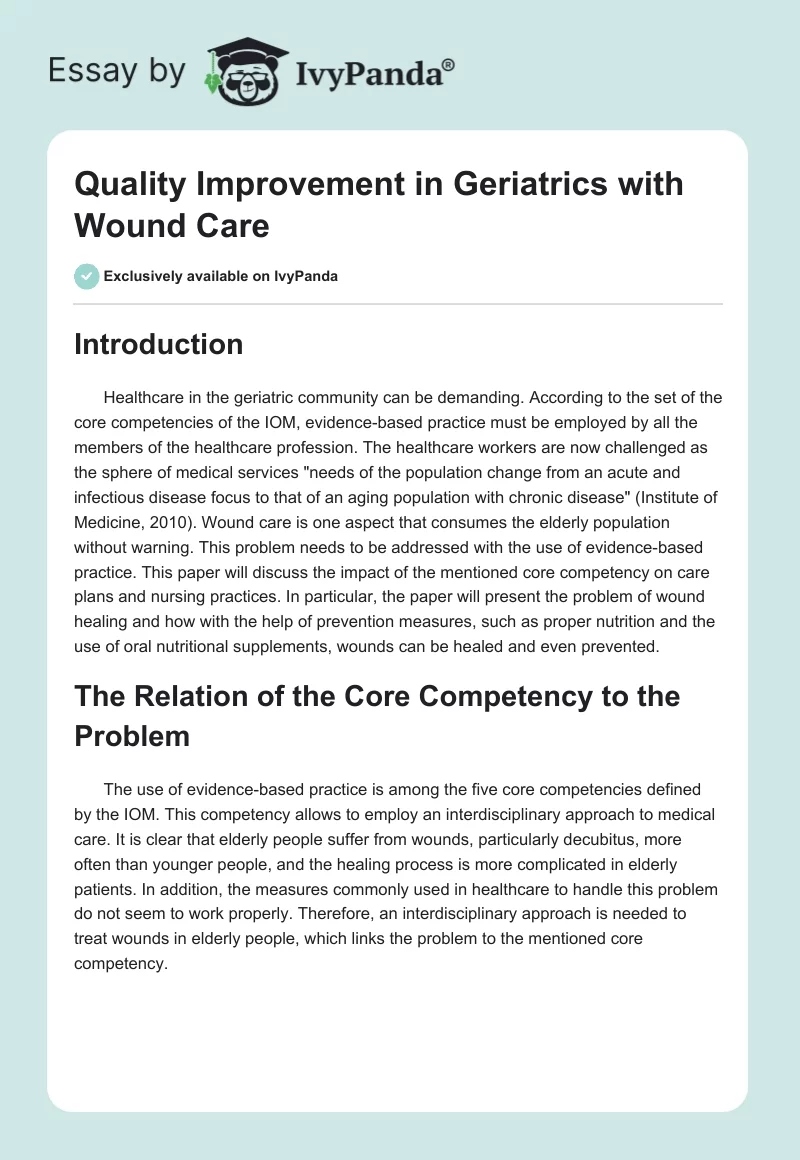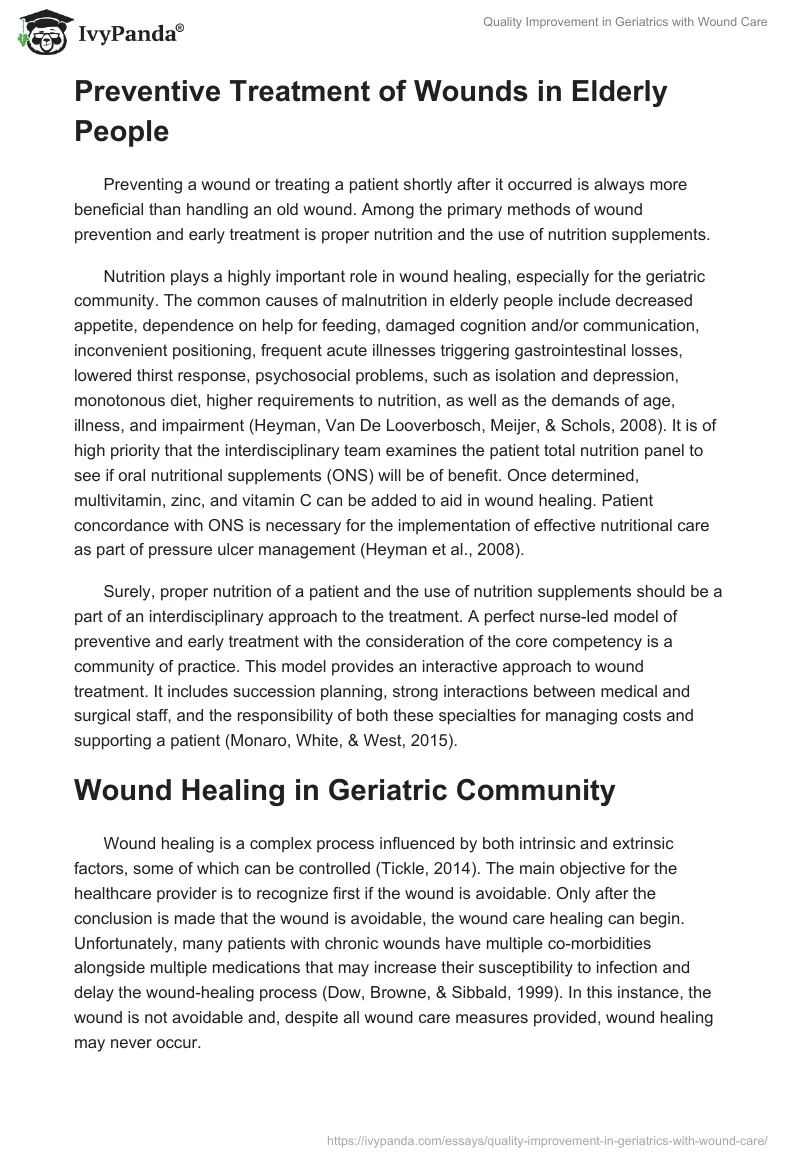Introduction
Healthcare in the geriatric community can be demanding. According to the set of the core competencies of the IOM, evidence-based practice must be employed by all the members of the healthcare profession. The healthcare workers are now challenged as the sphere of medical services “needs of the population change from an acute and infectious disease focus to that of an aging population with chronic disease” (Institute of Medicine, 2010).
Wound care is one aspect that consumes the elderly population without warning. This problem needs to be addressed with the use of evidence-based practice. This paper will discuss the impact of the mentioned core competency on care plans and nursing practices. In particular, the paper will present the problem of wound healing and how with the help of prevention measures, such as proper nutrition and the use of oral nutritional supplements, wounds can be healed and even prevented.
The Relation of the Core Competency to the Problem
The use of evidence-based practice is among the five core competencies defined by the IOM. This competency allows to employ an interdisciplinary approach to medical care. It is clear that elderly people suffer from wounds, particularly decubitus, more often than younger people, and the healing process is more complicated in elderly patients. In addition, the measures commonly used in healthcare to handle this problem do not seem to work properly. Therefore, an interdisciplinary approach is needed to treat wounds in elderly people, which links the problem to the mentioned core competency.
Preventive Treatment of Wounds in Elderly People
Preventing a wound or treating a patient shortly after it occurred is always more beneficial than handling an old wound. Among the primary methods of wound prevention and early treatment is proper nutrition and the use of nutrition supplements.
Nutrition plays a highly important role in wound healing, especially for the geriatric community. The common causes of malnutrition in elderly people include decreased appetite, dependence on help for feeding, damaged cognition and/or communication, inconvenient positioning, frequent acute illnesses triggering gastrointestinal losses, lowered thirst response, psychosocial problems, such as isolation and depression, monotonous diet, higher requirements to nutrition, as well as the demands of age, illness, and impairment (Heyman, Van De Looverbosch, Meijer, & Schols, 2008).
It is of high priority that the interdisciplinary team examines the patient total nutrition panel to see if oral nutritional supplements (ONS) will be of benefit. Once determined, multivitamin, zinc, and vitamin C can be added to aid in wound healing. Patient concordance with ONS is necessary for the implementation of effective nutritional care as part of pressure ulcer management (Heyman et al., 2008).
Surely, proper nutrition of a patient and the use of nutrition supplements should be a part of an interdisciplinary approach to the treatment. A perfect nurse-led model of preventive and early treatment with the consideration of the core competency is a community of practice. This model provides an interactive approach to wound treatment. It includes succession planning, strong interactions between medical and surgical staff, and the responsibility of both these specialties for managing costs and supporting a patient (Monaro, White, & West, 2015).
Wound Healing in Geriatric Community
Wound healing is a complex process influenced by both intrinsic and extrinsic factors, some of which can be controlled (Tickle, 2014). The main objective for the healthcare provider is to recognize first if the wound is avoidable. Only after the conclusion is made that the wound is avoidable, the wound care healing can begin. Unfortunately, many patients with chronic wounds have multiple co-morbidities alongside multiple medications that may increase their susceptibility to infection and delay the wound-healing process (Dow, Browne, & Sibbald, 1999). In this instance, the wound is not avoidable and, despite all wound care measures provided, wound healing may never occur.
Unfortunately, evidence-based care for the assessment and management of wounds in elderly people is a rare occasion. It is therefore needed to perform proper training of medical staff in the sphere of wound and ulcer treatment and establish a competency framework. It was proven that such measures would have a positive effect on the outcomes of wound treatment (Sprakes & Tyrer, 2010). The appropriate model of treatment with the consideration of the core competency should be multi-model and involve administrative support with nursing staff involved at the level of patient care, working out a set of care measures that is infused into the routine practice of care, and keeping accurate documentation on the patient and treatment process. In addition to this, the measures should be cost-effective and should consider the importance of skin care (Mallah, Nassar, & Badr, 2015).
Conclusion
Wound care is one of the significant aspects of care needed in the geriatric community. The use of evidence-based practice, which, according to the IOM, is one of the core competencies, should be employed to change wound healing practices in geriatric community and improve the general situation. It is known that the cost of the treatment can easily increase if a wound is not treated immediately. The evidence suggests that with the help of nutrition, oral nutritional supplements and the proper wound care wounds and costs can be kept to a minimum. The ultimate goal, however, is prevention.
References
Dow, G., Browne, A., & Sibbald, R.G. (1999). Infection in chronic wounds: controversies in diagnosis and treatment. Ostomy Wound Management, 45(8), 23-27, 29-40.
Heyman, H., Van De Looverbosch, D., Meijer, E., & Schols, J. (2008). Benefits of an oral nutritional supplement on pressure ulcer healing in long-term care residents. Journal Of Wound Care, 17(11), 476-480.
Institute of Medicine. (2010). The future of nursing: Leading change, advancing health. Web.
Mallah, Z., Nassar, N., & Badr, L.K. (2015). The effectiveness of a pressure ulcer intervention program on the prevalence of hospital-acquired pressure ulcers: Controlled before and after study. Applied Nursing Research, 28(2), 106-113.
Monaro, S., White, M., & West, S. (2015). A community of practice as a model of nurse-led wound prevention and management. Wound Practice and Research: Journal of the Australian Wound Management Association, 23(4), 167-173.
Sprakes, K., & Tyrer, J. (2010). Improving wound and pressure area care in a nursing home. Nursing Standard, 25(10), 43-49.
Tickle, J. (2014). Quality dressings and assessment. British Journal of Nursing, 16(9), 486-488.


